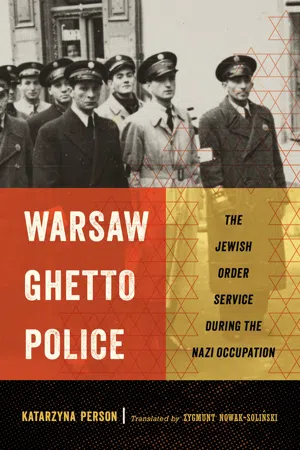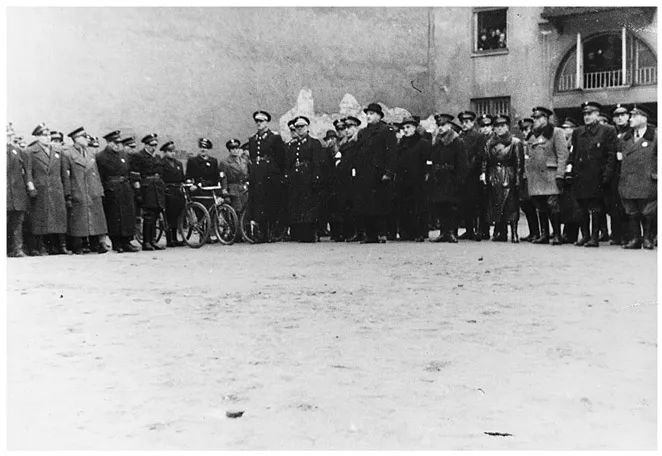CHAPTER 1
Establishment of the Jewish Order Service
Background
On September 20, 1940, the city governor of occupied Warsaw, Ludwig Leist, unexpectedly summoned Adam Czerniaków, chairman of the Judenrat (Jewish Council) in Warsaw.1 Czerniaków, then fifty-nine years old, was an engineer by training and a prewar social activist who proved to be a very capable administrator, skillfully maneuvering between German demands and the needs of the community entrusted to him. On that day, as Czerniaków wrote in his journal, “a senior official from the district” ordered him to establish a “Jewish Order Service”—a Jewish police force that would be the Jewish equivalent of the Policja Polska Generalnego Gubernatorstwa (Polish Police of the General Government), known as the Blue Police.
As in several other ghettos, in Warsaw the Jewish Order Service was not created as a new entity but was based on an already existing paramilitary organization, in this case the Security Guard of the Judenrat’s Labor Battalion.2 The Labor Department of the Jewish Council, later the Labor Battalion, was established at the Judenrat at the end of 1939 to facilitate the delivery of German-imposed quota of workers for forced labor. The department was at first subordinate to Section IVB of the German Security Police (Sipo) and the Security Service (SD), from mid-April to July 1940 to the Plenipotentiary of the Chief of the Warsaw District, and from July 1940 to the Labor Office in Warsaw (Arbeitsamt). As Czerniaków wrote in March 1940, this institution was set up by the Judenrat “on the one hand to satisfy the demands of the German authorities, and on the other to provide the impoverished population with the opportunity to earn a living.”3 From the beginning of March to the end of May 1940, a Security Guard of 111 people functioned as an extension of the Labor Battalion, dealing primarily with finding men who evaded compulsory labor. After the reorganization of the battalion at the end of May 1940, a separate unit was created from the Guard, and this became the nucleus of the later Jewish Order Service. At that time, the responsibilities of the Guard became much broader. Its members were among others overseeing the construction of a wall around the area of the future ghetto. Beginning in the summer of that year, the Guard patrolled the Jewish Cemetery, where gravestones had been defaced and broken.4 It also provided security in the Labor Office building and other Jewish Council offices.5 In late July and early August 1940, official instructions and internal regulations were drawn up for the Guard.6
The transformation of the Security Guard into the Jewish Order Service was defined by the Germans as part of the Selbständige Autonomie (Self-Regulating Autonomy) of the Jewish community in Warsaw. This was also the general feeling on the ghetto’s street.7 On March 29, 1940, historian Emanuel Ringelblum, the founder of the Underground Archive of the Warsaw Ghetto and an extremely astute observer of wartime reality, wrote, “Today, there were rumors that the fences around the ghetto area will be replaced with walls. In connection with this, [the prospect of a] ghetto in Warsaw is again seriously discussed, as are the several hundred Jewish policemen the Gmina [Jewish Community, meaning the Judenrat (Jewish Council) and all subsidiary organizations], it was said, is to recruit. Everyone is pulling strings to get these sought-after positions.”8
While similar Jewish guard organizations responsible for ensuring security had been created in almost all the larger ghettos in occupied Poland, the establishment of a Jewish law-enforcement body is not mentioned in any of the documents regarding the creation of ghettos in the General Government—neither in the express letter of September 21, 1939, from the head of the Reich Main Security Office (RSHA), Reinhard Heydrich, to the commanders of operational groups of the Security Police, nor in the September 13, 1940, decree by the governor-general of the occupied Polish territories, Hans Frank, or Frank’s executive regulations issued on September 21.9 Heydrich’s Schnellbrief mentions only concentrations of Jews from the provinces in larger cities and the creation of a council of elders in each Jewish community, which was to be “fully responsible, in the literal sense of the word, for the exact and prompt implementation of directives already issued or to be issued in the future.”10 Heydrich does not specify what measures of enforcement the Jewish councils would have at their disposal. Frank’s decree of November 28, 1939, specified the composition and manner of appointing Jewish councils, but it did not mention auxiliary organs. The regulations for this decree, dated April 25, 1940, reported that all orders for Jewish councils would be transferred through district authorities, which explains the manner in which information on the establishment of the Jewish Order Service was passed to Czerniaków.11 The governor of the Warsaw District, Ludwig Fischer, included no orders pertaining to the service in the order on the creation of the Warsaw Ghetto issued on October 2, 1940.12
Importantly, the Jewish Order Service was not directly incorporated into the German Order Police (Ordnungspolizei, or Orpo). Instead, it was explicitly set up as subordinate to the Polish police force under the occupation authorities, popularly referred to (in order to distinguish it from the prewar Polish State Police and to underline its character as part of the German system of oppression) as the “Blue Police.” The Blue Police was established on October 30, 1939, by the Higher SS and Police Leader in the General Government, Friedrich-Wilhelm Krüger, and was strictly subordinated to the Orpo.13 In terms of composition, it was a direct continuation of the prewar Polish State Police. Its members included functionaries of the prewar state police, excluding those of non-Polish ethnicity; its personnel and organizational structure in Warsaw maintained its fundamental continuity. The police wore the prewar navy-blue uniforms of the state police, except that the Polish eagle on their caps was replaced with the coat of arms of the capital of the district in which they served.
The Jewish Order Service had, in reality, to submit to all the decisions of the Blue Police, and the head of the service had to submit his orders for their approval. The Blue Police also controlled the composition of the service: it approved candidates for employment, promotions, and demotions. In organizational terms, the Jewish Order Service in the General Government was subordinate to the local Blue Police headquarters. In Warsaw, the Jewish Order Service was directly supervised by the Blue Police commander there, Col. Aleksander Reszczyński, although his deputy, Maj. Franciszek Przymusiński (commander after the assassination of Reszczyński in 1943), was much more often in the ghetto and became a link between the two organizations.14 In everyday matters, the Jewish Order Service reported to the Warsaw-North Command, headed by Mieczysław Tarwid. Members of the Jewish Order Service were also supervised in part by the leadership in Blue Police precincts remaining within the territory of the ghetto. Lack of clear legal guidelines often led to lack of clarity regarding the exact relationship between the Jewish Order Service and various levels of the Blue Police, with Jewish policemen often at a loss as to whom they should be addressing.15 German authorities in some cases defined the relationship between these institutions—for example, issuing orders for the Blue Police to assist the Jewish Council when requisitioning apartments in “Aryan” houses in the ghetto, after the change of ghetto borders.16
FIGURE 3. Adam Czerniaków (in a bowler hat) with functionaries of the Jewish Order Service and the Polish Blue Police, late 1941. Source: JHIA, ARG I 683-58.
Thus, the Jewish Order Service in Warsaw was not, by definition, an independent organization but only an auxiliary service that performed tasks imposed on it by the German administration, the Blue Police, and the Judenrat. The first two of these organs played a crucial role in this system of control; one former Jewish policeman, in his wartime report, described the German authorities as supervisory and decision-making and the Blue Police as monitoring and administrative.17 At the same time, however, the scope of authority of these bodies constantly overlapped, forcing the service’s leadership to dedicate a significant portion of its activity to maneuvering between the expectations of various individuals, often of conflicting opinions, who played significant roles in the Jewish Order Service and who exploited it to achieve their private goals. The formation of the service, as defined by one of its members, lawyer Stanisław Adler, was based on the shifting sands of German legislation that denied Jewish authorities any real powers.18 Despite the support of the Blue Police, the real power of the Jewish Order Service in Warsaw until the deportation period in summer 1942 was relatively limited in comparison with similar organs in other ghettos in the General Government. Its power did not increase, and unlike in other ghettos, the Jewish Order Service did not become fully independent from the Judenrat. This seems to be the case not so much due to the strength of the Warsaw Judenrat but to the limited contacts between the leadership of the Jewish Order Service and the German authorities. These contacts were taken over by a network of Gestapo informers—independent of the service and in competition with it—some of whom acted openly under the Office for the Prevention of Usury and Speculation (part of what was widely known as the “Thirteen” [Trzynastka], as they were located at 13 Leszno Street in the Warsaw Ghetto). The Thirteen combined the goals of economic exploitation with quasi-charitable activity and informing the Gestapo about events in the ghetto.
The lack of top-down regulations regarding the appointment and operation of Jewish law-enforcement bodies led to significant differences in the functioning of these formations in various localities.19 Although the functioning of the security services largely depended on local conditions, in most cases the establishment of the Jewish Order Service had a similar purpose that was related to the registration of Jews and their exploitation as a work-force and later included the seizure and spoliation of property and the assembling of the Jewish population and its supervision.20
No evidence has come to light that would establish whether there were any working relations between the Jewish Order Service in Warsaw and similar formations emerging in other ghettos of the General Government. Of course, this does not mean that no contacts were made, especially with regard to Jewish law-enforcement organizations in other large ghettos or ghettos near Warsaw, such as the Otwock Ghetto. According to Gazeta Żydowska (The Jewish Gazette), a Polish-language propaganda newspaper overseen by the German authorities and distributed in the ghettos of the General Government, security formations in other localities were modeled on the organization in the Warsaw Ghetto, from which they often asked “for technical guidance and information.”21
Policemen
Adam Czerniaków received the official order to organize the Jewish Order Service on October 12, 1940, along with information about the creation of the Warsaw Ghetto. The next day, at a meeting of the Judenrat, an inspection committee was chosen to oversee the selection of future members of the service.22
In Warsaw, as in other ghettos, the selection of the appropriate person to head the local Jewish Order Service was left to the chairman of the ghetto’s Judenrat. According to T. (Tadeusz?) Witelson, an officer of the service and at the same time a contributor to the Underground Archive of the Warsaw Ghetto, the commander was elected at an informal meeting held at 69 Pańska Street, in the apartment of Leopold Kupczykier, the owner of a confectionary factory and a member of the Judenrat in Warsaw.23 Also said to have been present were Judenrat member and prewar judge Edward Kobryner, Adam Czerniaków, and Józef Szeryński. The latter was a candidate for the position of commander of the Jewish Order Service in Warsaw, a convert to Catholicism, and a prewar officer of the Polish State Police, currently an office worker.24
Józef Szeryński
Józef Szeryński, a m...

